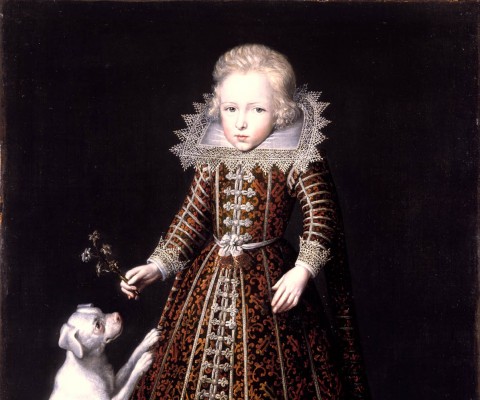Duke Ulrik
Portrait of Duke Ulrik (1611-33), painted by Jacob van Doort, who painted several portraits for the Danish court in the time of Christian IV. Van Doort also worked for several other European royal houses.
The portrait must have been painted around 1615, since the duke is about 4 years old in the picture — this can first and foremost be seen from his clothing.
The painting is a representative portrait, which includes several symbols which express something about the sitter: On the left hand side there is a small, white Chinese pug, a breed of dog which was popular at European courts, first and foremost because it was rare. In his hands, he holds a small bouquet of flowers, most likely carnations.
There are no corresponding paintings of Christian IV’s other children at Rosenborg. It may be presumed, however, that all who were legitimate or accepted at the court must have had their portraits painted.
The other portraits of Duke Ulrik portray him either as an older child or as a young man. The painting therefore also plays an important role as part of a complete series of portraits of a royal child in the Renaissance.
Duke Ulrik’s children’s clothes
The portrait is interesting not least because of the very detailed depiction of the boy’s clothing. Royal portraits often display the rich fabrics, lace, and trimmings in such a lifelike way that one cannot be in doubt about the quality of the materials.
The clothing takes the form of a dress, which was identical for boys and girls until the age of six. It is tightly fitted (over a corset, which small children also had to wear), and the skirts reach the ground. It has long, decorative hanging sleeves, which were also seen in adult clothing, but had the extra advantage for children that they could be used as supports when the child had to learn to walk.
The seams of the clothes are decorated with thin, woven stripes of silver thread, and the dress is closed in the middle with braiding made of decorative buttons and loops. The buttons are sewn of silver thread in a checkerboard pattern over a little wooden ball. This kind of fastening was used in particular on clothes made of fine or heavy fabrics, since it avoided the need to cut buttonholes in the fabric. This meant that the fabric could be reused at a later date. The buttons and loops were also more flexible than buttons and buttonholes, especially when the child was still growing.
Duke Ulrik’s white collar sits up around his ears, held up by a kind of frame called a supportasse. Just a few years later the fashion changed and men desired longer hair, so the collars had to be lowered, and lay on the shoulders in order to make room for the hair.

 Dansk
Dansk
 English
English
 Deutsch
Deutsch


